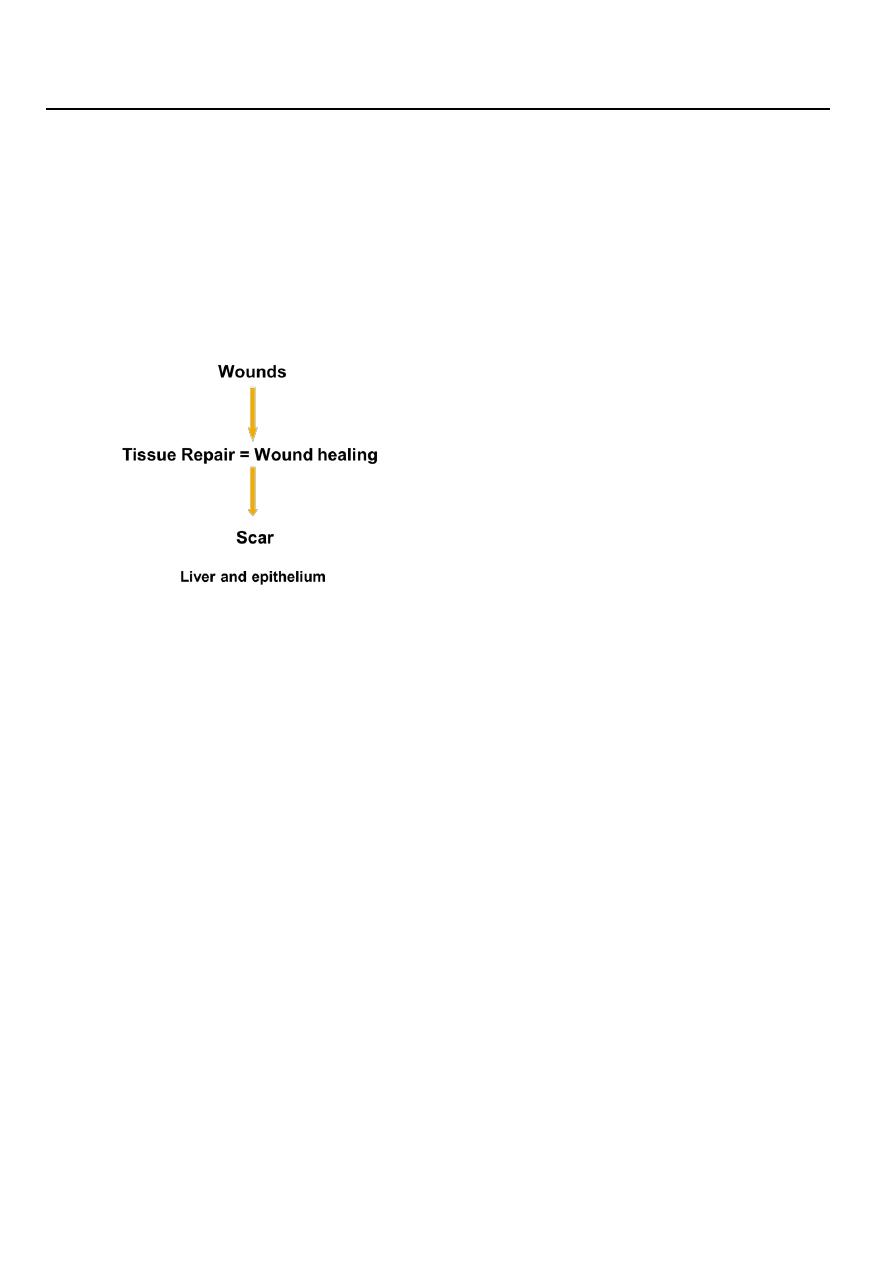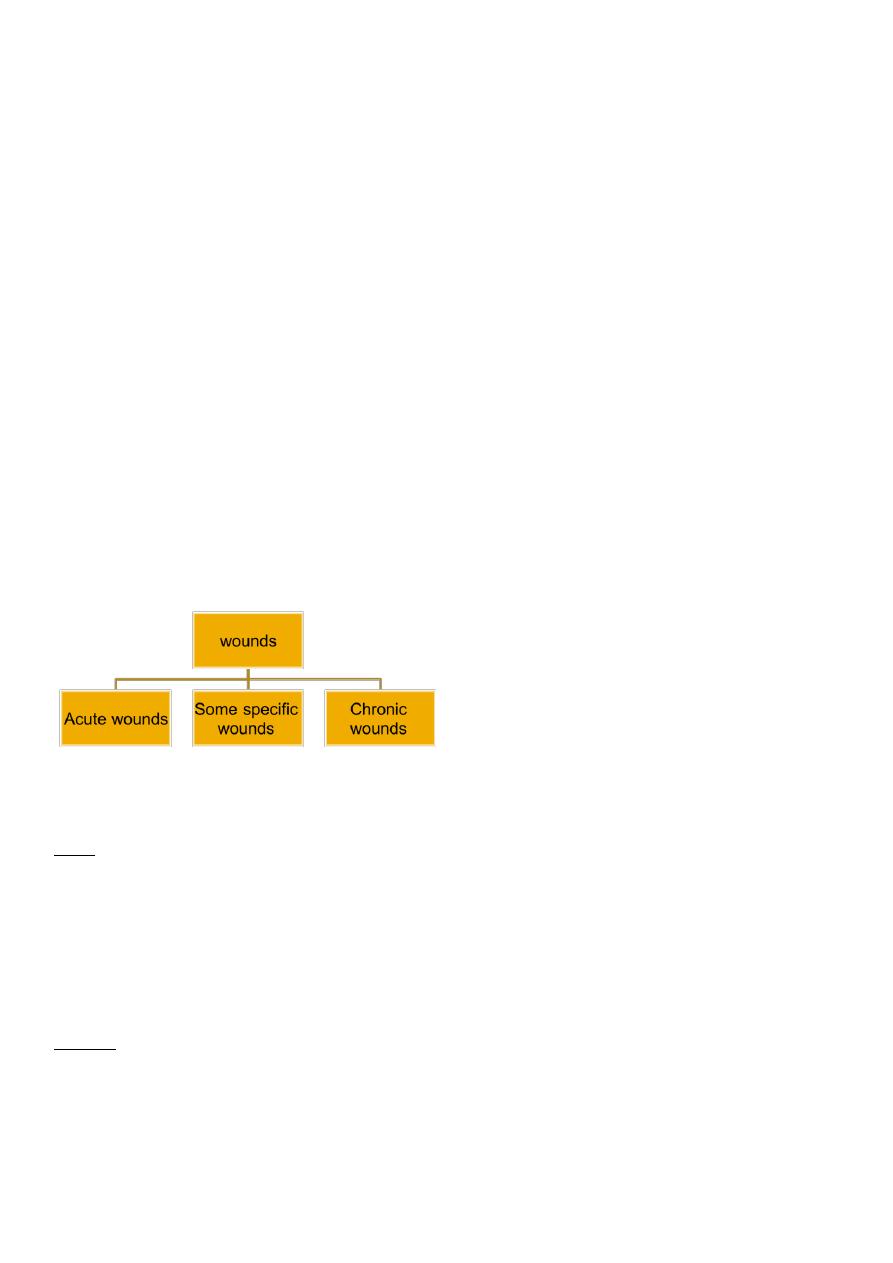
1
Third stage
Surgery
Lec-1-2
.د
موفق
1/1/2014
Wounds, Tissue repair and Scars
Definition:
Wound: It is a break in the continuity of the skin, mucous membrane or any other tissue
caused by physical, chemical or biological insult.
Is it important?
Surgeons induce tissue injuries as part of their access ,
It is a common casualty complaint.
Wound healing:
an orchestrated biological process initiated by tissue injury and results in restoration
of tissue integrity. The end result of repair process is fibrosis and scar formation.
This process is defined theoretically into three phases.
Phases of wound healing:
Inflammatory phase (Early): 0 – 3 days.
Proliferative phase (Intermediate): 3rd day – 3rd week.
Remodelling Phase (Late): up to 1 year
Inflammatory phase (Early):
o Hemostasis:
Vasoconstriction,

2
Platelets aggregation,
Activation of coagulation system.
o Inflammation:
Neutrophils act to sterilize the wound.
Monocyte will continue phagocytosis and secrete several growth factors.
Proliferative phase (Intermediate):
o Fibroplasia:
Deposition of collagen fibers to form the extra-cellular matrix.
o Angiogenesis:
New capillary networks which comes from endothelial cell division and migration.
"Granulation tissues" consist of new blood vessels, macrophages, fibroblasts
embedded in a loose matrix of collagen.
o Contraction:
wound is pulled circumferentially toward the center by specialized Myofibroblast to
decrease the size of the wound.
o Epithelilisation:
epidermis migrate over the wound defect thus forming a barrier to further
contamination.
Remodelling Phase (Late):
o The collagen fibers align with the skin tension lines to increase the tensile strength of
the skin.
o However, at best it only reach approximately 80% of the normal skin.
Factors affect wound healing :
o Local factors :
Site of the wound, structures involved and mechanism of wounding e.g. incision,
crush and avulsion.
Ischemia.
Infection.
Foreign bodies and necrotic tissues.

3
Chronic venous insufficiency and tissue oedema.
Ionizing radiation.
o Systemic Factors
Systemic diseases
Malnutrition: Vit C deficiency results in inadequate collagen production.
Drugs: steroid and chemotherapeutic agents for cancer therapy.
Types of wound healing:
Primary Healing: wound edges opposed, normal healing and minimal scar.
Secondary Healing: The wound left open to heal by granulation, contraction and
epithelialisation. There will be increased inflammation and proliferation with poor
scar.
Tertiary Healing: wounds initially left open and the edges opposed later when healing
conditions favourable.
Classification of wounds:
Acute wounds:
Tidy:
Sharp instrument e.g. surgical incisions or wound by glass or knife,
it contains no devitalized tissue
little contamination and seldom has tissue loss.
These wounds are usually single with clear cut.
closed immediately with expected good healing and minimal scar.
Untidy:
blunt injuries e.g. crushing, tearing, avulsion.
It has a dead tissue
significant contamination and often has tissue loss.
They are often multiple and irregular.
If closed immediately, healing is unlikely and associated with wound complications.

4
Management: 1. Assessment
History:
Examination:
o Generally:
o Locally:
Supportive measures:
Local wound care
Wound excision:
o The process of removal of the dead tissue from the wound.
Wound closure:
o Primary closure: the edges of the wound are approximated. The wound will heal
by primary intention with minimal scaring e.g. Tidy wounds
o Healing by secondary intention: In untidy wounds, it require serial wound excision
and cannot be closed. These wounds are left open for care and dressing until
healing achieved by granulation with significant scaring.
o Delayed Primary Closure: Sometimes Untidy wounds can be converted to tidy
wounds which can be closed directly.
o Tissue Transfer: when there tissue loss, appropriate tissue need to be transferred
into the defective area e.g. Skin graft.
Some specific wounds
Contusion, Bruises:
o closed wounds
o blunt trauma
o bleeding into the tissues with visible discoloration.
o hematoma which can resolve spontaneously or it may need drainage or repeated
aspiration.
Bites:
o Animal/ human bites.
o Aerobic and anaerobic organism prophylaxis required as bites wound typically
have high virulent bacterial counts and proper wound excision.
Puncture wounds:
o open wounds
o penetrating injuries e.g. standing on a nail or sharp objects, or needle stick
injuries.
o foreign bodies and microorganism are likely to be carried deeply into the tissues.
o The danger is, it might give rise to deep abscess.

5
Degloving:
o skin and the S.C. fat are stripped by avulsion from its underlying fascia,
o It could be open injury e.g. ring avulsion or closed injury e.g. roll-over injury
typically caused by motor vehicle over a limb.
Scars:
o Is the inevitable consequences of wound repair.
o "Remodelling“: immature collagen fibers replaced by acellular, avascular tissue
composed of mature collagen fibers.
o red, raised, firm area to pale, flat, soft and symptomless mature scar.
o The appearance of the scar from red, raised, firm area to pale, flat, soft and
symptomless mature scar.
o Factors:
age of patient,
site of the wound,
time the wound took to heal and
direction of the scar and the tension across it.
o Complication of Scar:
Hypertrophied scar:
more cellular and vascular with
increased collagen production than
mature scar.
Clinically it is red, raised, itchy and
tender but confined to the wound
site.
It tends to occur in wounds whose
healing has delayed because of
infection or dehiscence.
spontaneous resolution .
Keloid scar:
extensive growth of the scar beyond
the wound site.
It is biologically identical to
hypertrophied scar.
They often occur in wounds which
healed without complications.
It rarely subside with time and
require active treatment.
